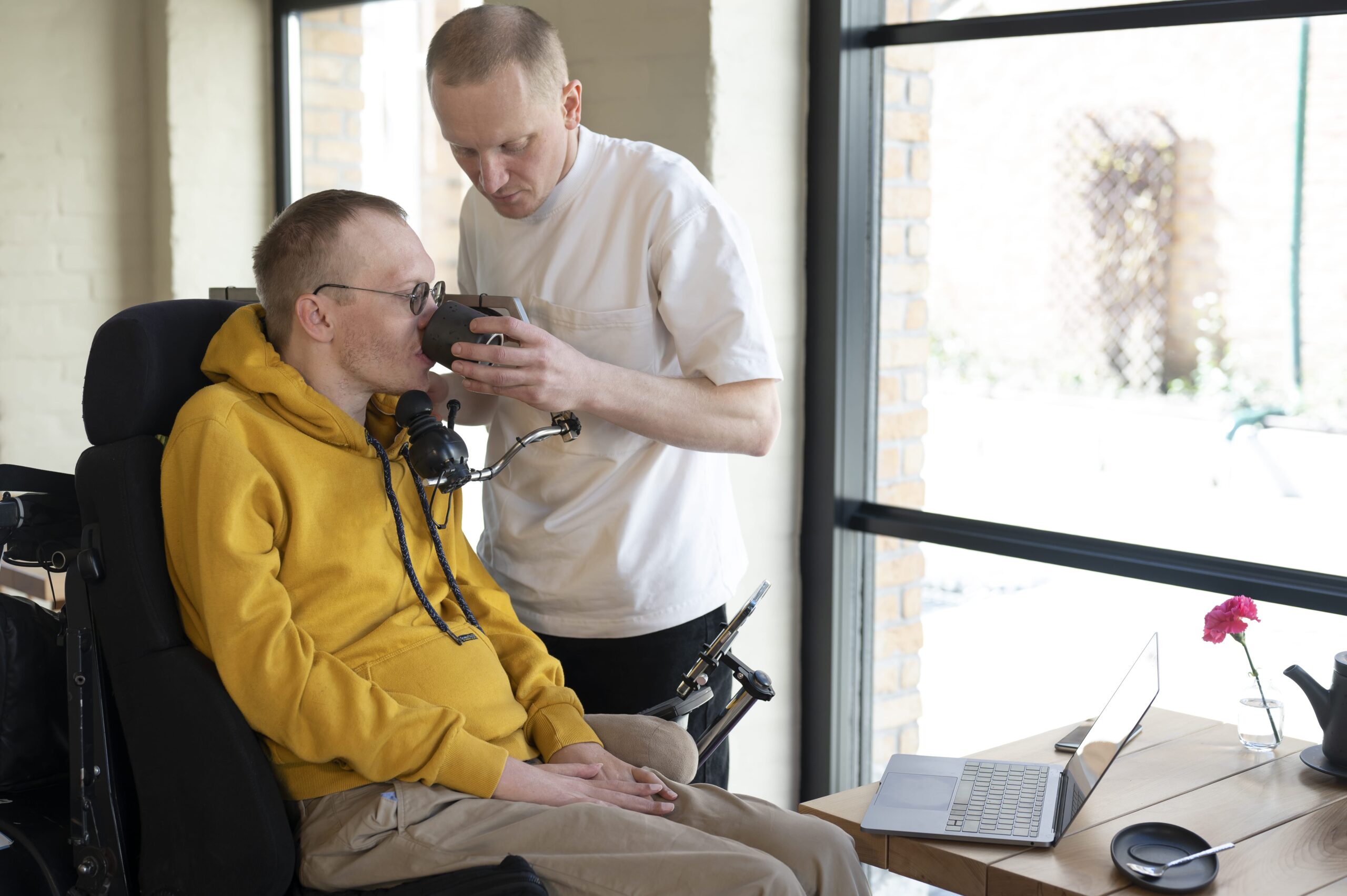SIL and SDA seemed like the same thing, nearly missed out on the support that changed everything.
This is what one NDIS participant shared after finally understanding the difference between these two crucial support options. Like many people navigating the NDIS system, they had been confused by the acronyms and almost settled for less support than they actually needed.
Here’s a surprising fact: 94% of NDIS participants are eligible for SIL support, but only 6% qualify for SDA, yet most people don’t understand which category they fall into or why it matters for their independence and quality of life.
Let’s break down everything you need to know about Supported Independent Living (SIL) and Specialist Disability Accommodation (SDA) in simple, practical terms.
What is SDA (Specialist Disability Accommodation)?
Specialist Disability Accommodation (SDA) is about where you live. SDA provides specially designed housing with features that support people with significant functional impairments or complex support needs.
SDA homes are designed and built to provide high-quality living arrangements for people with disabilities, with features like wheelchair accessibility, sensory integration, and specialised technology to enhance independence.
It provides reasonable and necessary modifications to everyday environments to increase independence and access to opportunities for people who need it.
The purpose of Supported Disability Accommodation is to provide participants with housing and help disabled people live more independently while having access to support services when needed. It can also help reduce the need for more intensive support services over time. This type of accommodation is designed so that people with disabilities can live in their homes in a way that suits their needs and preferences.
What is SIL (Supported Independent Living)?
Supported Independent Living (SIL) offers disabled people the freedom and flexibility to live in their own homes with the right level of support tailored to their needs. SIL can include a range of daily living services such as support with meal preparation and eating, personal care, cleaning, and laundry, help with shopping and banking and receiving daily support with tasks. The level of support is designed to help you live as independently as possible while ensuring your health and safety needs are met.
SIL aims to give you more control over your life by giving you the help you need to make independent decisions about how you want to live your life—and allowing you to take on more responsibility for your care.
SIL vs SDA: Side-by-Side Comparison
| Aspect | SIL (Supported Independent Living) | SDA (Specialist Disability Accommodation) |
|---|---|---|
| Focus | Support services and assistance | Modified housing and accommodation |
| What it covers | Personal care, daily living support, skill development | Specially designed housing with accessibility features |
| Funding type | Core Support budget | Capital Support budget (separate from other NDIS funding) |
| Location flexibility | Can be provided anywhere you live | Specific SDA-enrolled properties |
| Eligibility | Based on support needs assessment | Strict eligibility criteria – only 6% of NDIS participants qualify |
| Duration | Ongoing as per NDIS plan | Long-term housing solution |
| Independence level | High level of choice and control | May have more structured environment |
| Cost to participant | Covered by NDIS plan | Covered by NDIS (no rent to participant) |
Can You Have Both SIL and SDA?
Yes! Many people benefit from both SIL and SDA. You might live in an SDA property (specially modified accommodation) and receive SIL support (daily living assistance). These supports complement each other – SDA provides the right physical environment, while SIL provides the personal support you need.
SIL vs SDA: Which is Right for You?
When deciding between SIL (Supported Independent Living) or SDA (Specialist Disability Accommodation), it is essential to consider your individual needs and preferences. SIL offers independence and freedom, allowing you to enjoy independent living with support as needed.
On the other hand, SDA provides high-complex support to individuals with severe functional impairments. For example, if you have an NDIS plan, you may be eligible for funding for either option. It’s best to consult with your support team and NDIS plan manager to determine which accommodation type best suits your needs and preferences as an NDIS participant.
Choosing Your Path: SIL or SDA?
We’re here to simplify your journey towards Supported Independent Living. Contact us today and let’s get started on your SIL application process.
Advantages of SIL and SDA
Supported Independent Living (SIL) and Specialist Disability Accommodation (SDA) offer unique advantages for individuals with functional impairments. Here are some of the benefits:
Advantages of SIL:
- It provides individuals with greater independence and control over their daily routines
- Allows for a more flexible living environment with less structure and support than SDA
- Offers a greater sense of privacy and autonomy
- It may be more cost-effective than SDA
Advantages of SDA:
- Provides high support needs for individuals with significant functional impairments
- Offers specialized equipment and facilities designed to meet the needs of individuals with disabilities
- It can provide a higher level of support and structure than SIL, which may be necessary for some individuals
- May be available with NDIS funding to eligible participants
Ultimately, the choice between SIL and SDA will depend on your individual needs and preferences and your eligibility for NDIS funding. Therefore, it’s vital to consult with your support team and NDIS plan manager to determine which option best suits your situation.
The Levels of Support Offered by SIL and SDA
Supported Independent Living (SIL) and Specialist Disability Accommodation (SDA) offer different levels of support to people with disabilities, enabling them to enjoy independence and live as fully as possible.
SIL supports people who want to live independently, either in their own homes or shared homes. It offers assistance with household tasks, such as cooking and cleaning, and helps with managing finances, accessing education and employment, and building social skills and relationships. SIL is suitable for people who can manage many aspects of their daily lives but require some support to help them live independently.
On the other hand, SDA is designed for people who require highly complex support due to their disability. SDA provides specially designed accommodations with wider doorways, hoists, and wheelchair-accessible bathrooms to help with mobility and independence. It also offers on-site support staff to assist with daily living tasks, access to specialised equipment and technology, and assistance with complex medical needs, such as wound care and medication management. In addition, SDA is suitable for people who require a high level of support to live independently.
Disability services include both SIL and SDA, and the level of support offered can vary depending on the individual’s needs and preferences. For example, SIL is ideal for people who prefer to live in a shared home or want to live alone, whereas SDA is designed for people who require a higher level of support and may not be able to live alone. Ultimately, both SIL and SDA aim to provide people with disabilities the support they need to enjoy independence and live their lives to the fullest.
Illuminate Your Understanding: SIL vs. SDA
Shed light on your understanding of SIL and SDA. Contact us now and let us guide you through their unique features.
Best Resources for Getting Started with SIL and SDA
Ready to get started but don’t know where to begin? There are numerous excellent resources out there that can help you learn the basics of SIL and SDA and the differences between them. Here are some of the best ones:
Accessibility & Usability Guidelines
Official accessibility and usability guidelines provide information on how disabled people can access websites and applications more efficiently. Many of these guidelines are available online or from local government agencies.
Online Tutorials
It’s not just official guidelines – there are plenty of online tutorials that can help you develop a better understanding of SIL and SDA for disabled people. These tutorials typically include step-by-step instructions for setting up accessibility options within a platform or application and best practices for testing and verifying your work.
Accessibility Software Solutions
If you want to become proficient in SIL or SDA quickly, you may want to consider investing in software solutions specifically designed for accessibility needs. These software tools typically provide an easy-to-use interface that allows users to promptly tweak settings such as text size and colour contrast to create an accessible experience.
How Can Choosing Wise Choice help you in SDA and SIL?
Wise Choice can be immensely helpful in ensuring that you or your loved one receives the best care and support possible. We will provide high-quality accommodation that is safe, comfortable, and suitable for individuals with disabilities and ensure that the accommodation is designed and equipped to meet the specific needs of the residents and promote their independence.
Our team of experts is trained to give residents the assistance they require. They will be knowledgeable and skilled enough to assist with personal care, medication management, and other assistance requirements. We will help to ensure that each person with a disability receives the specific support they require to live independently and achieve their goals.
Choosing a wise choice In-Home Care for SDA and SIL can provide peace of mind that you or your loved one will receive high-quality care and support in a safe and comfortable environment. We will work closely with residents to develop personalised care plans and provide access to resources and a supportive community.
Please contact us if you want to discuss your NDIS accommodation or accessible housing needs.
Conclusion
It’s easy to get confused by the acronyms and the terminology in the disability world. Still, it is essential to understand the differences between Supported Disability Accommodation ( SDA) and Supported Independent Living (SIL) to become empowered and make informed decisions about the care and support you or your loved one needs.
Deciding which is suitable for you or your loved one is a complex decision, and it’s always best to work with a qualified professional to ensure you understand the different funding options and how they could impact the care and support you or your loved one can access. Regardless of your choice, it is essential to remember that people with disabilities have the right to pursue their goals regardless of their racial or economic background.
So, if you’re searching for an NDIS-registered provider, look no further. Wise Choice in-home Care is a registered NDIS service provider in Australia. Our team at Wise Choice works hard to deliver high-quality support services and to assist people with disabilities who need NDIS assistance in achieving their goals.


